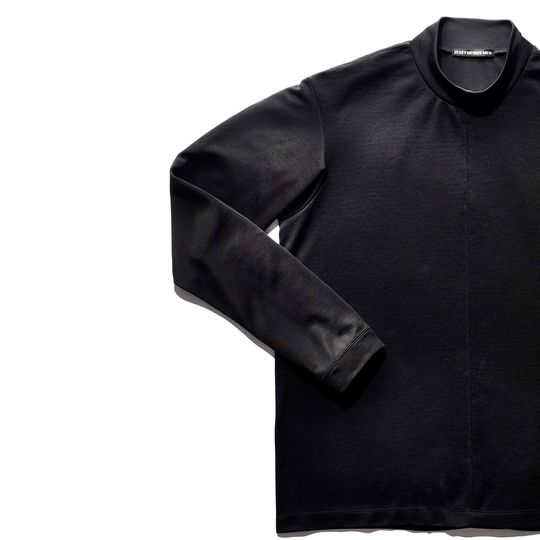Geek chic: dress like Steve Jobs (assuming you'd want to...)

Of the many technological and artistic triumphs of the fashion designer Issey Miyake – from his patented pleating to his soulful sculptural forms – his most famous piece of work will end up being the black mock turtleneck indelibly associated with Apple co-founder Steve Jobs.
The model was retired from production in 2011, after Jobs’s death, but in July, the innovative craftsman’s eponymous clothing brand is releasing a US$270 garment called the Semi-Dull T. It’s 60 percent polyester, 40 percent cotton, and guaranteed to inspire déjà vu.
Don’t call it a comeback. The company is at pains to state that the turtleneck, designed by Miyake protégé Yusuke Takahashi with a trimmer silhouette and higher shoulders than the original, isn’t a reissue.
And even if the garment were a straight-up imitation, its importance as a cultural artifact is more about the inimitable way Jobs wore it.
For Jobs, this way of dressing was a kind of consolation prize after employees at Apple resisted his attempts to create a company uniform.
In the early 1980s he’d visited Tokyo to tour the headquarters of Sony Corp., which had 30,000 employees in Japan. And all of them – from co-founder Akio Morita to each factory worker, sales rep, and secretary – wore the same thing: a traditional blue-and-white work jacket.
In the telling of Jobs biographer Walter Isaacson, Morita explained to Jobs that Sony had imposed a uniform since its founding in 1946. The workers of a nation humiliated in war were too broke to dress themselves, and corporations began supplying them with clothes to keep them looking professional and create a bond with their colleagues.
In 1981, for Sony’s 35th anniversary, Morita had commissioned Miyake, already a fashion star after showing innovative collections in Paris, to design a jacket. Miyake returned with a futuristic taupe nylon model with no lapels and sleeves that unzipped to convert it into a vest.
Jobs loved it and commissioned Miyake to design a vest for Apple, which he then unsuccessfully pitched to the Cupertino workforce. “Oh, man, did I get booed off the stage,” Jobs told Isaacson. “Everybody hated the idea.”
Americans, with their cult of individuality, tend not to go in for explicit uniformity, conforming instead to dress codes that aren’t even written yet.
This left Jobs to contrive a uniform for himself, and he drew his daily wardrobe from a closet stocked with Levis 501s, New Balance 991s, and stacks of black mock turtlenecks – about 100 in total– supplied by Miyake.
How Jobs came to settle on this particular item of clothing isn’t recorded, but it had long been a totem of progressive high-culture types – San Francisco beatniks, Left Bank chanteuses, and Samuel Beckett flinching at the lens of Richard Avedon.
In the analysis of costume historian Anne Hollander, the existentialist black turtleneck indicates “the kind of freedom from sartorial convention demanded by deep thought,” and it’s tempting to read Jobs’s as the descendant of that symbol.
His turtleneck was an extension of his aesthetic aspirations: severe but serene, ascetic but cushy. The garment, as Jobs wore it, was the vestment of a secular monk.
The shirt put an especially cerebral spin on the emerging West Coast business-casual look, implying that the Apple chief had evolved past such relics as neckties – an anti-establishment gesture that set a template for hoodie-clad Mark Zuckerbergs and every other startup kid disrupting a traditional dress code.
In its minimalism and simplicity, the black turtleneck gave a flatscreen shimmer to Jobs’s self-presentation, with the clean lines of a blank slate and no old-fashioned buttons.
Jobs was hardly the first to celebrate freedom from choice by selecting a rigidly regular look as a sort of mask and armor.
But his style, despite its pretense of normcore anonymity, was and remains uniquely distinctive. The co-identity of man and garment is so intense, it forces you to wonder whether the new Miyake sweater will, despite its inherent virtues, find an audience.
The original ranks as a trademark on par with Andy Warhol’s silver wig, and you may need to stick your neck out to make it your own.




30 Aug 2013
Total posts 438
$270 for 60% polyester.
It's a no from me.
Hi Guest, join in the discussion on Geek chic: dress like Steve Jobs (assuming you'd want to...)